英汉对比之综合语与分析语解析
- 格式:ppt
- 大小:3.51 MB
- 文档页数:102
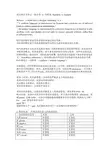
英汉语言差异之一综合语vs 分析语Synthetic vs AnalyticWebster’s Ninth New Collegiate Dictionary定义“A synthetic language is characterized by frequent and systematic use of inflected forms to express grammatical relationships.””An analytic language is characterized by a relatively frequent use of function words, auxiliary verbs, and changes in word order to express syntactic relations, rather than of inflected forms.综合语的特征是运用形态变化来表达语法关系。
分析语的特征是不用形态变化而用词序以及虚词来表达语法关系。
现代英语是从古代英语发展出来的,仍然保留着综合语的某些特征,但是也具有分析语的特点:有形态变化,但不象典型的综合语那么复杂;词序比汉语灵活,但相对固定;虚词很多,用的也相当频繁。
现代英语运用遗留下来的形态变化形式(hereditary inflections),相对固定的词序以及丰富的虚词来表达语法关系,因此属综合-分析语(synthetic-analytic language)。
形态变化,词序和虚词是表达语法意义的三大手段。
这些语法手段在英汉语言中都具有不同的特征。
此外,英语采用拼音文字,句有语调intonation;汉字绝大多数为形声字,字有声调tone。
英汉表达方法的差异与这些因素均有密切的关系。
英语(词语)有形态变化,汉语没有严格意义上的形态变化。
英语词序比较灵活,汉语词序相对固定。
英汉都有大量虚词,但是各有特点。
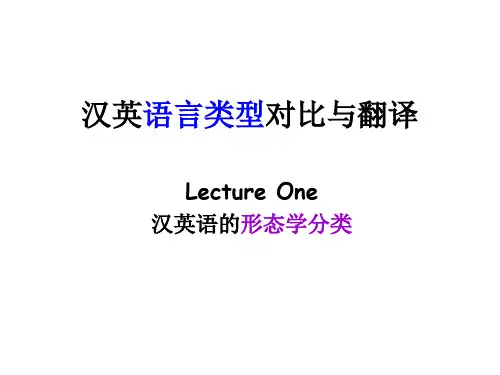
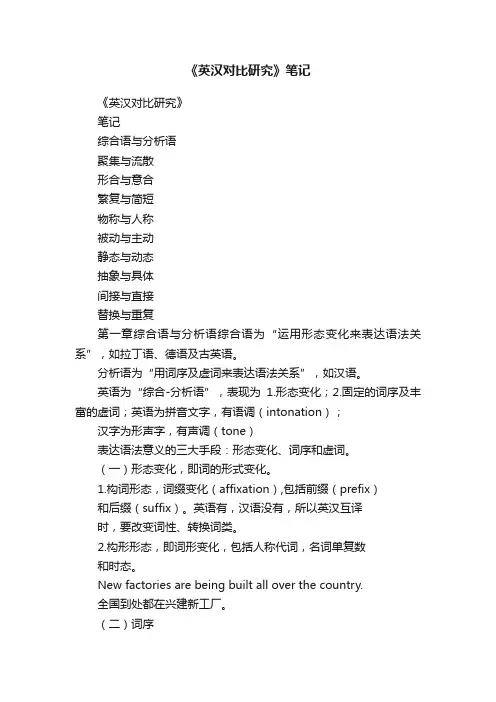
《英汉对比研究》笔记《英汉对比研究》笔记综合语与分析语聚集与流散形合与意合繁复与简短物称与人称被动与主动静态与动态抽象与具体间接与直接替换与重复第一章综合语与分析语综合语为“运用形态变化来表达语法关系”,如拉丁语、德语及古英语。
分析语为“用词序及虚词来表达语法关系”,如汉语。
英语为“综合-分析语”,表现为1.形态变化;2.固定的词序及丰富的虚词;英语为拼音文字,有语调(intonation);汉字为形声字,有声调(tone)表达语法意义的三大手段:形态变化、词序和虚词。
(一)形态变化,即词的形式变化。
1.构词形态,词缀变化(affixation),包括前缀(prefix)和后缀(suffix)。
英语有,汉语没有,所以英汉互译时,要改变词性、转换词类。
2.构形形态,即词形变化,包括人称代词,名词单复数和时态。
New factories are being built all over the country.全国到处都在兴建新工厂。
(二)词序形态变化越多的语言,词序越灵活,反之亦然。
英语词序比汉语灵活的一个表现就是英语中的倒装句。
原因就是“形态变化”和“连接词”;而中文缺乏形态变化,少用或不用连接词,词序较固定。
形态变化规则要求句中词语之间保持语法关系一致,只要词语之间前后呼应,就容易灵活安排;汉语无这种一致的关系,只能按照表意的需要排序词序。
a)He had to quit the position and went in exile, having beendeprived of his power.他被剥夺了权力之后,只好离职,流落他乡。
b)a very important questiona question of great importance一个很重要的问题c)at an unprecedented speedat a speed unprecedented以空前的速度d)There is no inconsistence in what he said.There is nothing inconsistent in what he said.他说的话并没有前后矛盾之处。
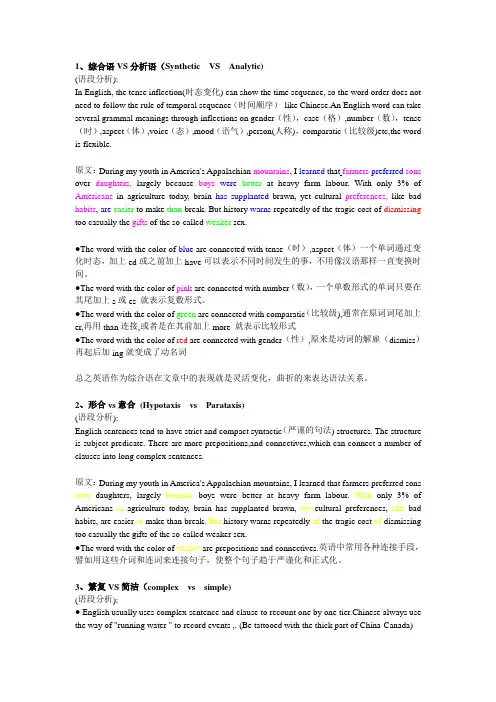
1、综合语VS分析语(Synthetic VS Analytic)(语段分析):In English, the tense inflection(时态变化) can show the time sequence, so the word order does not need to follow the rule of temporal sequence(时间顺序)like Chinese.An English word can take several grammal meanings through inflections on gender(性),case(格),number(数),tense (时),aspect(体),voice(态),mood(语气),person(人称),comparatic(比较级)etc,the word is flexible.原文:During my youth in America's Appalachian mountains, I learned that farmers preferred sons over daughters, largely because boys were better at heavy farm labour. With only 3% of Americans in agriculture today, brain has supplanted brawn, yet cultural preferences,like bad habits, are easier to make than break. But history warns repeatedly of the tragic cost of dismissing too casually the gifts of the so-called weaker sex.●The word with the color of blue are connected with tense(时),aspect(体)一个单词通过变化时态,加上ed或之前加上have可以表示不同时间发生的事,不用像汉语那样一直变换时间。

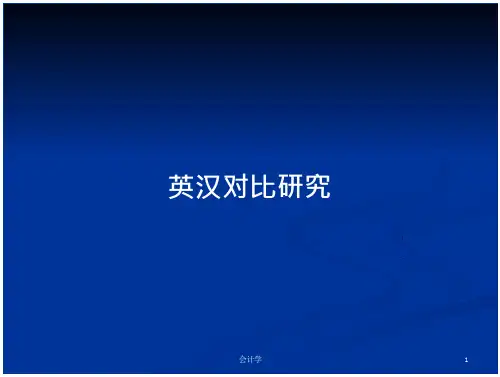
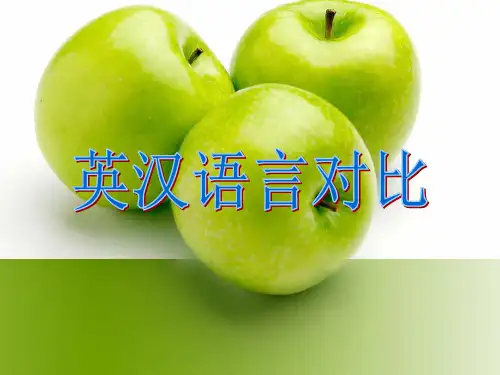


浅谈现代汉语分析型与英语综合型致使结构分析对比-教育文档浅谈现代汉语分析型与英语综合型致使结构分析对比1 分析型与综合型语言英语和汉语隶属两种不同类型的语言代表,二者由各自的语系经历长时间的过度最终构成各自鲜明的特点。
其中英语是典型的综合型语言,它隶属于印欧语系,而现代汉语则是由综合型的古汉语逐渐过渡为高度分析型语言。
综合性语言,如英语,主要是通过其词汇本身形态变化来表达其意义,包括时态、数、语态等等。
分析型语言,如汉语,并不通过词汇本身的形态变化而是通过语法关系来表达意义。
归根到底是因为英语和汉语的词汇从词库中出来就带有不同的性质。
虽然现代汉语具有高度的分析性,但是古汉语却具有高度的综合性,如今在现代汉语中又发现一些词汇呈现综合型特征,这些都反映出语言演变遵循一种循环模式,从综合到分析再到综合。
(黄正德,柳娜2014)致使(causation)这类语义关系是普遍存在于各种语言中的跨语言语义现象。
它用以表达一个复杂事件中子事件A与另一子事件B之前存在的某种关系,A导致B的出现;或A使B产生。
其中A为使因事件,B为使果事件。
(韩景泉,徐晓琼2016)在英语中,一些词汇从词库中出来就隐含“致使”的含义。
常见的有“bore、amaze、astonish、interest”等包含致使义的动词,它们在英语中被称为使役动词。
这些词从词库中出来就带有隐性致使轻动词“cause”,因此,这些使役动词的语义形态结构应为“Cause(covert)+ Verb”。
相反,汉语词汇从词库中出来并不携带“致使”含义,而是在句法层面与显性轻动词相结合,构成致使结构。
2 现代汉语分析型致使结构作为典型分析型语言代表的汉语,其语言的发展并非一直沿着分析型的道路发展,追溯回古代汉语,可从一些古汉语例证中找到综合型语言的踪迹。
在古汉语中,一些词如“渔、饭”等词,都是名字作动词用,其意义与现代汉语中的“打鱼、吃饭”一样,这种在古汉语中名词作动词的用法可归结于古代汉语综合型的体现,其结构是由一个隐性的轻动词与名词构成,即“LV + N”(Light + Verb)。

50从综合语与分析语的角度来看《名利场》的中英差别■董 倩/桂林理工大学摘 要:本文从英汉综合语与分析语的角度出发,从形态、语序和虚词三大语法手段来对《名利场》中的中英译文进行对比分析,找出英、汉语在表达语法时使用方式的差异。
关键词:综合语 分析语 中英差异一、综合语与分析语综合语是指运用形态变化来表达语法关系的语言,形态变化包括构词变化和构形变化。
英语的动词,助动词和情态动词常结合起来,运用其形态变化来表达动词的时、体、语态和语气。
而分析语是指用语序和虚词来表达语法关系的语言,汉语就是典型的分析语。
二、从综合语与分析语的角度分析名利场的中英差异(一)形态变化对比形态变化主要包括构词形态和构形形态。
词语前、后缀的使用属于构词形态,英语的词缀数量多且种类全,但汉语的词缀规模小且种类少。
如: “and simply means that women are commonly not satisfied until they have husbands and children on whom they may centre affections.”(他们认为女人的情感平时只能零星发泄,必须有了丈夫和孩子,情感收聚起来有了归宿。
) 从文中可以看出affections 通过在词尾添加后缀“-s ”来表示其复数,属于构词形态的变化。
但汉语中的“情感”不能添加任何词缀,既可表单数也可表复数,因此没有构词形态的变化。
(二)语序对比形态变化与语序有密切的关系,形态变化越多,语序越灵活。
英语是属于语序较为灵活的形态语言。
汉语没有形态变化,因此词的语序不能随意变动。
英语多是结构倒装,汉语多是功能倒装。
比如:“as for saying an unkind word to her , were any persons hard-hearted enough to do so …”(假如有硬心肠的人责骂了她.).这里的“were any persons ”采用的倒装结构,省略了“if ”表达一种假设。
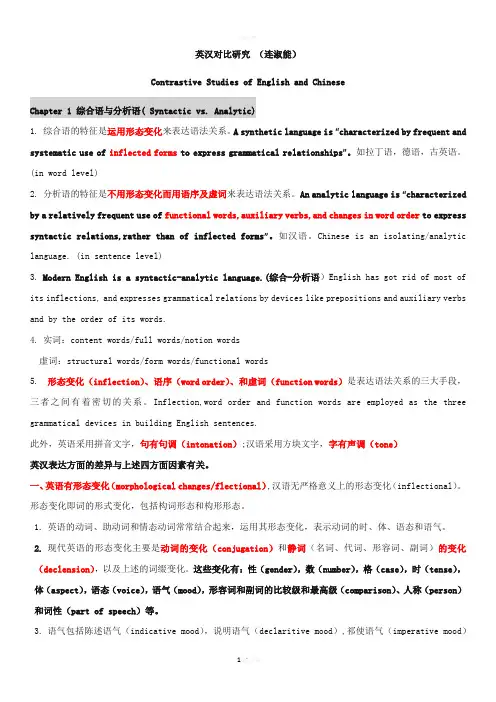
英汉对比研究(连淑能)Contrastive Studies of English and ChineseChapter 1 综合语与分析语( Syntactic vs. Analytic)1.综合语的特征是运用形态变化来表达语法关系。
A synthetic language is “characterized by frequent and systematic use of inflected forms to express grammatical relationships”。
如拉丁语,德语,古英语。
(in word level)2.分析语的特征是不用形态变化而用语序及虚词来表达语法关系。
An analytic language is “characterized by a relatively frequent use of functional words,auxiliary verbs,and changes in word order to express syntactic relations,rather than of inflected forms”。
如汉语。
Chinese is an isolating/analytic language. (in sentence level)3.Modern English is a syntactic-analytic language.(综合-分析语)English has got rid of most of its inflections, and expresses grammatical relations by devices like prepositions and auxiliary verbs and by the order of its words.4.实词:content words/full words/notion words虚词:structural words/form words/functional words5.形态变化(inflection)、语序(word order)、和虚词(function words)是表达语法关系的三大手段,三者之间有着密切的关系。
英汉词语表达的: 分析性和综合性analytic expression and synthetic expressionOutlineAnalytic & synthetic expression related to degree of lexicalizationFactors for the occurrence of lexicalizationDifferent degree of lexicalization in word-formationDifferent degree of lexicalization in parts of speechImplications for C-E and E-C translationAnalytic & synthetic expressionSynthetic expression (i.e., one word) is often sufficient to combine what analytic expression can only achieve by using multiple words.Synthetic expression characterized by high degree of lexicalization while analytic by lower degree of lexicalization.Factors for lexicalization1. Grammar2. Condensing3. Frequency4. CultureGrammarChinese –the tendency of analytic: limited affixes; disyllables; single morpheme words in decline; various predicate structuresEnglish – the tendency of synthetic:free morpheme (-ful /full –less/leas -ship/shape)mouthful/ spoonful/ eventful/ hopeful…fruitless/ sleepless/ useless/ homeless…friendshi p/ partnership/ membership/ citizenship…Condensing物色——绢帛之类贵重丝品——用物色来寻求、交易——寻求(王灿龙2005)帝思其贤,乃物色求之。
1、综合语VS分析语(Synthetic VS Analytic)(语段分析):In English, the tense inflection(时态变化) can show the time sequence, so the word order does not need to follow the rule of temporal sequence(时间顺序)like Chinese.An English word can take several grammal meanings through inflections on gender(性),case(格),number(数),tense (时),aspect(体),voice(态),mood(语气),person(人称),comparatic(比较级)etc,the word is flexible.原文:During my youth in America's Appalachian mountains, I learned that farmers preferred sons over daughters, largely because boys were better at heavy farm labour. With only 3% of Americans in agriculture today, brain has supplanted brawn, yet cultural preferences,like bad habits, are easier to make than break. But history warns repeatedly of the tragic cost of dismissing too casually the gifts of the so-called weaker sex.●The word with the color of blue are connected with tense(时),aspect(体)一个单词通过变化时态,加上ed或之前加上have可以表示不同时间发生的事,不用像汉语那样一直变换时间。